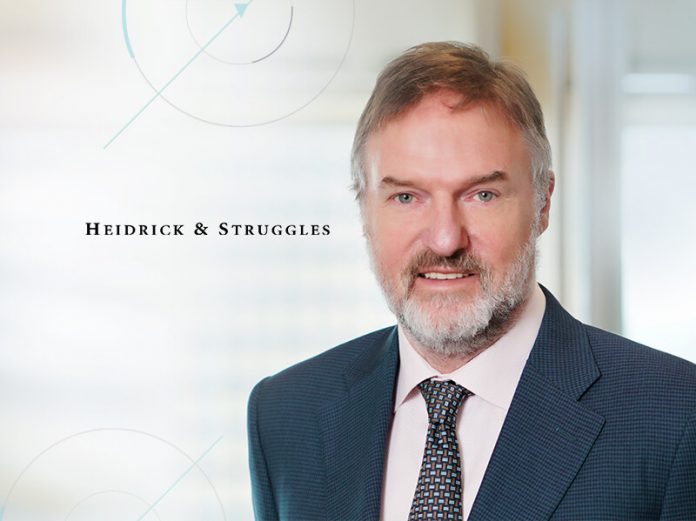Interview with Mr. Ian Johnston, Partner at Heidrick & Struggles
It’s common to refer casually to a company’s “culture”. But what does that really mean anyway and, more importantly, is it really relevant to the success or otherwise of an organisation? As Ian Johnston of Heidrick & Struggles explains, business leaders would be well advised to pay attention to “shaping” their companies’ culture.
Can you summarise what a) company culture is and b) what good company culture looks like?
Culture is a powerful invisible force, the set of unspoken assumptions that shapes the everyday experience of people connected to an organisation, both inside and out. When tightly linked to strategy, with leaders as role models, culture is a potent component of performance and competitive advantage. Culture is not a programme or an initiative – it’s a drumbeat that runs through an organisation.
Good company culture looks like an environment where every person is informed and guided by the same shared values and goals. The most effective cultures are the delivery system for an organisation’s strategy and a key driver for financial performance. The phenomenon of the “Shadow of the Leader” means that the most senior leaders in an organisation have a disproportionate influence on the everyday working experience of all employees. Good company culture includes those leaders being the positive role models for the shared values and goals.
Why / how does intentionally building company culture positively impact financial performance?
If you do not intentionally build the culture you want, you will get the culture you deserve. Our survey, Aligning Culture with the Bottom Line: How Companies Can Accelerate Progress, shows that 82% of CEOs said they had made culture a key priority over the past three years. Out of a range of organisational priorities, only 31% picked improving financial performance as their primary goal.
There was a small group, 11 per cent of the total, which we labelled the “Culture Accelerators”. They achieved growth over a three-year period that was twice that of the other 89 per cent. Of all the variations that were examined (22 different iterations), there were three correlating elements that appeared each time that were common to the culture accelerators. These were that CEOs had to:
1. Have a strong personal belief that culture is either very important or crucial to the financial performance of their organisations;
2. Embed culture front and centre in their strategy early, and see culture as the foundation to the delivery of their strategy, and do not leave it until later as a “nice to have”;
3. Put in place a robust delivery process to reach all employees and communicate to their organisations the importance of culture to give it credibility.
The financial performance of these culture accelerator companies was more than double that of other companies surveyed (CAGR of 9.1 per cent over three years vs 4.4 per cent for the others). CEOs can’t be passive in their efforts and expect culture to take care of itself or delegate it to someone else.
In a recent survey that your company carried out, you found that while most executives prioritise culture, often to improve financial performance, most of them aren’t particularly intentional in pursuing it to reach that goal. Why do you think this is, and how can you encourage leaders to be more proactive in seeking out a stronger organisational performance?
Only 70 per cent of British CEOs said they had actually made culture a key priority over the last three years, compared to 82 per cent of CEOs surveyed overall. This might explain why CEOs in the United Kingdom also deviated from the global standard when asked what they believed were the most important drivers of financial performance, with the vast majority answering that agility and innovation were. The findings of our survey suggest that there is a disconnect between intentional culture and strategy building in the leadership of the UK CEOs surveyed.

There was also a significant difference between the things that CEOs saw as the most important culture drivers of financial performance and those that they felt were commonplace in their own organisations, suggesting that CEOs are less intentional than one might think on how to address financial performance through the lens of culture.
The CEO respondents were asked to look at eight essential drivers of culture and to rank those that they considered most important in creating a positive impact on financial performance. Later in the survey, they were asked which of the same eight essential drivers were most commonplace in their own organisations. Over 80 per cent of the respondents had only one or no matching items. This suggests that, whilst CEOs recognise the importance of culture, they are not as intentional as they might be on promoting characteristics that directly influence financial performance
The findings of the survey highlight the tendency of many UK CEOs to prioritise engagement with their employees, and they do this far more than their global counterparts. UK CEOs are keen to personally promote organisational culture and systemic alignment between culture efforts and other company processes. They are therefore more concerned with culture that encourages growth mindsets, with long-term focus on customer and quality service, and believe these elements to be vital for yielding the most positive financial outcomes.
It is pretty clear that CEOs with a strong personal belief that culture drives financial performance, that culture is the delivery platform for strategy and who also create a strong delivery process to engage their entire organisation significantly increase the probability that they are going to have two things, irrespective of geography sector and size:
1. Increased financial performance (in this case over a three-year period)
2. Greater collaboration and trust and an environment where each employee knows how their day-to-day work contributes to the performance of the organisation
In the study, who were the greatest and least “culture accelerators” by nation?
The table below shows the distribution for the nine countries that were included.

Based on the findings, is strategy and leadership a better foundation for increased financial performance than agility and innovation?
This is not a case of one or the other, especially if agility and innovation are core to the strategy. It is more about the ways that CEOs focus on culture, strategy, policies and processes or operating model to drive improved financial performance. We all know that digital transformations are ultimately successful not for the technology that is at the core, but rather the culture that enables the change to happen. CEOs face a blend of many things that matter and have to prioritise what they believe to be the right combination of those priorities.
Your company has been advocating for a marriage of culture and strategy to accelerate financial progress. For people who might not be familiar with the term, what exactly does “culture-shaping” entail?
The culture of a particular organisation or group consists of the habits of the people in it and the way they generally behave. Organisational culture is the collection of habits and beliefs of how things “ought” to be. Anytime you hear the words, “That’s just how things are done around here,” that’s culture. While leaders can’t fully control a complex entity like culture, you can do your part to shape it.
Conversely, when it feels really hard to get things done, when everything seems to take too much effort and people are not acting in the best interests of the organisation, that is the culture acting as a drag on progress. It is a bit like trying to drive a car with the brakes on.
As CEOs seek to help their companies thrive in the current hybrid, fast-changing environment, a thriving culture will be their best tool. The survey results reinforce the benefit companies can see when they link their culture to their strategy and create broad engagement with the culture. Our four principles of culture-shaping suggest how they can get started.
Is “culture” a subjective concept in leadership? Can there ever be unified understandings, or will there always be variances with leadership styles and locations?
Leadership and culture are intertwined. Leaders can fail in the short term because of a lack of culture fit in a strong legacy culture, yet in the long term, leadership is the single most important element and influence on culture.

Leadership needs to be aligned with culture, so that people’s energy and effort are pointed in the same direction. By having an agreed and common set of culture principles (not rules), leaders can bring their own experience and beliefs to bear, yet still be aligned with the organisation’s culture
The impact of culture is an invisible force that can be a powerful experience for good, or a toxic influence that can create misery. Leaders need to be aligned around a clear set of positive influences on culture. These are centred around a common language that supports the values and purpose of the organisation. This creates an experience of being led that transcends geographies, local culture and language, yet still gives respect to local differences and individual characteristics in leaders
How do you think the current hybrid and fast-paced working situation will affect organisational culture? What will leaders need to do more or less of, in order to keep nurturing thriving, high-performing company cultures?
Shaping culture in an organisation full of geographically dispersed people working together in virtual/hybrid teams is another challenge. It’s particularly important to focus on intentionally creating an organisational culture that’s shared when you’re trying to shape a remote work culture.
Whether leaders will have to do more or less will depend on the state of the organisation’s culture to begin with. If a company has a strong culture from prior to the pandemic and not too much churn, it may continue as normal. If the company did not dedicate time to nurturing and creating the culture, then leaders may need to do more to create a unified vision and culture.
Purposeful leadership
In the past year, we have seen data from other surveys and a great deal of anecdotal evidence showing that having a socially meaningful purpose has become a crucial characteristic of organisational leadership and culture across the globe. Key aspects of being purposeful as a leader are being inclusive, leading with influence instead of authority, and adapting leadership approaches to the way people work. Inclusive leaders also foster collaboration by involving many people in implementing new ideas, instead of operating in a silo and dictating change.
Personal change
Leaders who can live the culture and challenge others to do so will help build a leadership team of culture accelerators and connectors. Leaders who don’t currently make the links between culture and financial performance will benefit from shifting their mindsets in that direction.
Broad engagement
Many of the tactics used by culture connector CEOs, such as ensuring that employees at all levels of the organisation are appreciated and challenged, can help drive broad engagement. The more energetic and communicative leaders are about the culture-shaping process, the more likely it is that this momentum will spread throughout teams.
Systemic alignment
Along with recognising that culture-shaping must be reinforced across all parts of the organisation, leaders must ensure that talent development and review processes, onboarding, and training include ways to develop and bolster the aspects of culture that are most important to driving financial performance.
It goes without saying that remote working is very much to the fore these days. What are the challenges that these organisations may face and how would you address them?
Every company is grappling with the future of work and return-to-office scenarios. Few are settled. With COVID-19 variants still spreading, we remain in a prolonged period of uncertainty and vacillation for all leaders whose employees can work remotely.
I strongly believe that the hybrid model is the future of work. But, for leaders, it is also the most challenging of all possibilities to navigate. Getting hybrid right will require pausing and thinking about building on the gains of the past 18 months, rather than trying to recreate a past that is no longer viable, and it will require leaders to be agile and thoughtful in addressing five particular aspects of work that have undergone fundamental reassessment: inclusion, communication, career development, productivity, and innovation.
Leaders who create new paradigms for how we work can create thriving cultures with high engagement and performance, a critical advantage in an exploding war for talent. Four examples of challenges and possible solutions would be:
Inclusion: The prevailing view is that hybrid work (given that it is partly remote) and inclusivity are at odds, and that an organisation’s culture will erode in a distributed work environment. People who work remotely may feel excluded from key office-based activities.
Get to know team members as people, including their aspirations, preferences, and needs. On a broader scale, understand various employee personas to appreciate the breadth of needs across the organisation. Reach out to remote as well as in-person colleagues on a regular cadence to stay up-to-date on their needs and challenges. A unified purpose drives a sense of belonging and inclusion across the organisation.
Communication: Most leaders have communicated more transparently, frequently, broadly, and with more empathy since the beginning of the pandemic, yet have had to balance people’s desire for information with the information overload many people have felt.
Communicate early and often, even if you do not have all the answers. Transparently share the rationale behind leadership decisions to promote understanding, resilience, and loyalty, even when information is incomplete or still evolving. Seek organisational input and engagement more frequently via one-on-one engagement, pulse surveys, and virtual interactions.
Productivity: A big concern many leaders have with remote work is the loss of control that comes with the lack of visual line of sight to their workers. In the early days of COVID-19, we received numerous questions about how to manage performance virtually. Now, the best leaders have started to focus more on tracking output and outcome.
Design fit-for-purpose solutions. Have leaders evaluate different types of work or tasks and take a fresh, hard look at what will be required for maximum effectiveness. The nature of the work should define the way of working. Some tasks are best done remotely; others are enhanced by in-person collaboration. Others benefit from the broad, dispersed team that hybrid enables.
Innovation: Perhaps executives’ most common concern about hybrid work has to do with innovation, creativity, brainstorming, and collaboration. We used to come together for “whiteboarding” sessions. We would “huddle” when we needed to ideate, innovate, explore, learn, debate, discuss, or decide strategy. We can’t do that when everyone is remote.
Challenge old models and innovation assumptions. Take a fresh look at what work configurations, including remote ones, really stimulate creative disruption and design thinking. Design new innovation spaces and methods for in-person and virtual brainstorming. Encourage diversity of thought, talent, and teams both in terms of composition and tone of brainstorming sessions and seek out contrarians to whom you have more access virtually. Intentionally use digital tools to ensure every innovation team is diverse.

Technology is now seen as a necessary channel to cope with this new dimension of work. How do you think this trend will affect the dynamic of seeking out talent on demand?
It is clear that the technology that is now available enabled organisations to continue functioning during prolonged lockdown. This would not have been possible 10-15 years ago and it is hard to speculate how the world would have responded and the likely impact on economies and society without that technology.
What was clearly demonstrated was that remote working is a viable and, for many, preferable way of being employed. Many roles are now advertised and offered as remote and many have taken advantage of that to live in places that suit their lifestyle, not the needs of their employment.
This has become a core factor for some.
What leadership characteristics do you see as being the most needed in a post-pandemic world?
Organisations have radically altered how they work during the COVID-19 pandemic and, crucially, the changes have shifted perceptions of how work can be, and needs to be, done. Through the immediate crisis and continuing to the present, I’ve overwhelmingly heard, in conversations with leaders about habits from the past that have little place in the future: control, hierarchy, rigidity, certainty, and silos, for example.
Peoples’ experience of life dramatically shifted in a world suddenly rendered uncertain and unfamiliar. Faced with the biggest intractable problem in a generation, organisations dealt with disruption, discontinuity, and extreme challenges to their operating models. We had truly entered the realm of the “unknown unknown”, an environment with problems which we did not understand, and of which we were not even aware.
Leaders had to make major decisions quickly, based upon limited or ambiguous information. Leadership demanded courage, a strong sense of purpose, and a capacity to demonstrate the confidence needed to engage and inspire a workforce filled with worry and uncertainty. Inclusive leadership and cultures of inclusion become the keys to unlocking thriving organisations. Words like “empathy” became very important; some leaders needed to fundamentally re-evaluate their personal style of leadership. Many CEOs found themselves leading their organisations while having no physical connection with their people, products, or customers.
The crisis has tested leaders, and it is clear that disruption will continue. Upheaval will test our agility. Discontinuity and working from home will require us to deploy more strategies for inclusion in a hybrid environment. In this moment, we must all be learners – figuring out not how to simply make the best of it, but how to make it the best it can be. Leaders who make that mindset shift can propel themselves and their organisations forward to optimise their success now and in the future.
Heidrick & Struggles takes pride in serving clients as trusted advisors across the full suite of leadership needs. Is there a general, overarching end goal you wish to achieve?
Heidrick & Struggles was formed under the premise that helping organisations and their leaders allows us to create meaningful change within the world.
We are passionate about serving the senior-level talent and leadership needs of the world’s top organisations as a trusted advisor across executive search, leadership assessment and development, organisation and team effectiveness, and culture-shaping services. Today, the firm provides integrated leadership solutions to help our clients change the world, one leadership team at a time.
In the past 20 years, you’ve worked in over 63 countries and guided some of the biggest names in business today. What is the most valuable lesson you picked up along the way that leaders can benefit from today?
Aside from the three key factors that are mentioned elsewhere, if I had to pick one thing, it would be that the CEO and the executive team have to let their organisation know how much the culture of the organisation matters to them, be role models for that culture, and keep that message consistent over the long term. Far too many senior leaders create a lot of noise around the culture and then get busy with the “next thing”.
If you could leave CEOs with some words of advice about how to start intentionally building a better workplace culture, where would you suggest they start?
I would start with Purpose. If leaders are not clear about why their organisations exist, beyond generating returns for shareholders, then it is hard to create a meaningful environment. An effective and well defined Purpose is the central organising thought that sits at the heart of the organisation. The strategy and the culture that supports it should be firmly rooted in the Purpose.
It is also clear that the culture accelerators not only create increased financial performance, but also more positive cultures that are focused on collaboration and trust and communication, and also demonstrate a higher level of engagement in DE&I.
Shifting the focus to their people first, building collaboration and trust, and putting DE&I efforts front and centre is how they will see better financial performance.
It is worth noting, again, the three things that the survey identifies as defining the culture accelerators, which were that CEOs had to:
1. Have a strong personal belief that culture is either very important or crucial to the financial performance of their organisations;
2. Embed culture front and centre to their strategy early and see culture as the foundation to the delivery of their strategy, not leave until later as a ‘nice to have’;
3. Put in place a robust delivery process to reach all employees and communicate to their organisations the importance of culture to give it credibility.
This article was originally published on November 18, 2021.
Executive Profile

Ian Johnston is a partner in Heidrick & Struggles’ London office and a member of Heidrick Consulting’s global leadership team. He has more than 25 years’ experience working with CEOs and senior leaders to support the transformation of their organisations with a focus on purpose, growth mindset, and culture. Previously based in Singapore, Ian led and built Heidrick Consulting in APAC.



































